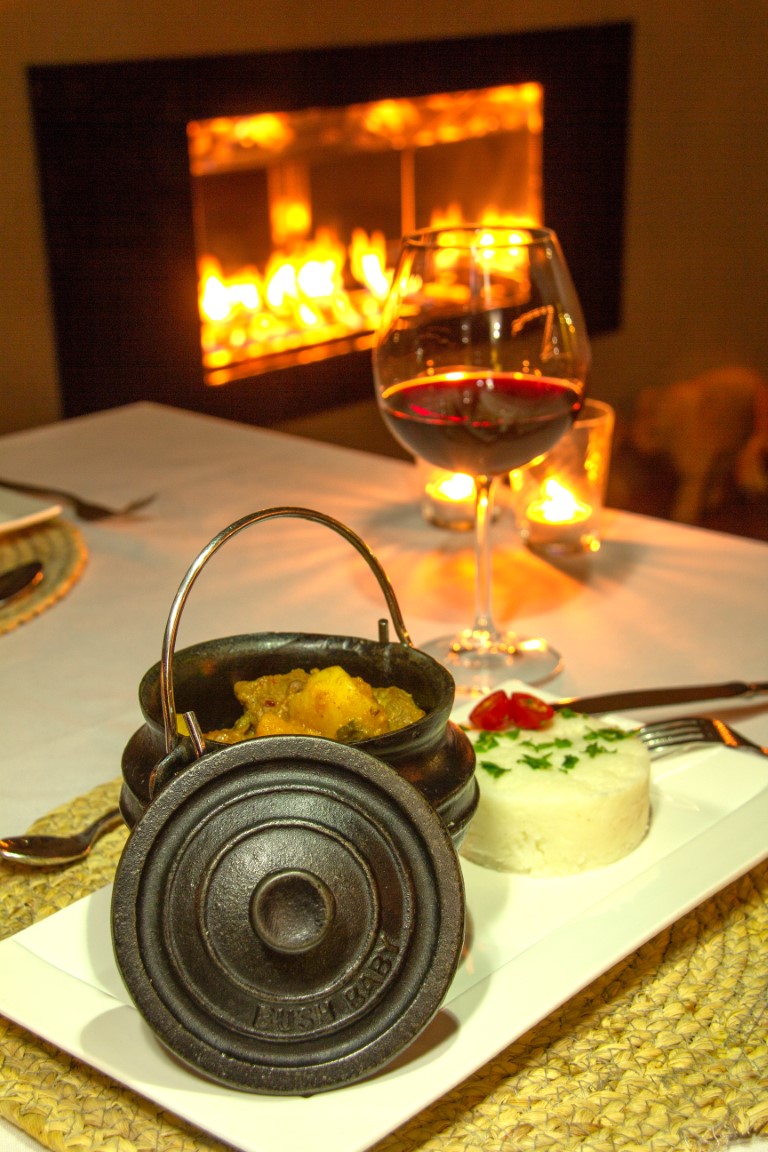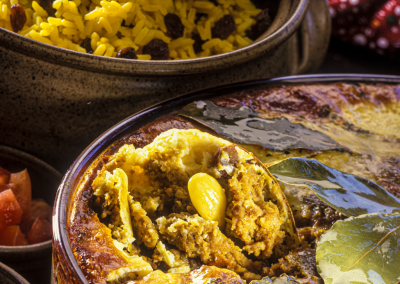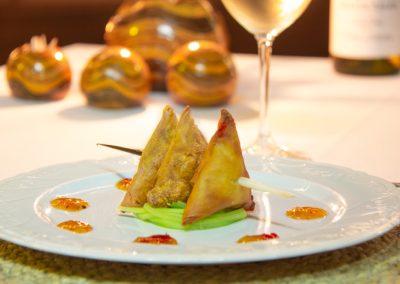South African cuisine is incredibly diverse, influenced by a variety of cultures and traditions, including indigenous African, Dutch, British, Malay, Indian, and more. Our chef at Casart Game Lodge cooks special South African dishes and from experience, these are incredibly appreciated. We invite you to come and taste a few of the South African dishes during our cosy dinners by candlelight.
Of course, we try to take into account individual wishes, such as vegetarian, gluten-free, Halaal. Unfortunately, we have to disappoint vegans.
An overview of some traditional South African dishes
- Bobotie: A baked dish made with spiced minced meat (often beef or lamb) mixed with fruits, nuts, and savoury spices, topped with an egg-based custard topping. It’s often served with rice or bread.
- Braai: Similar to a barbecue, braai is a popular social activity in South Africa and one of the most famous South African dishes. Various meats such as boerewors (sausage), steak, chicken, and lamb chops are grilled over an open flame. Sides like salads, chutneys, and bread are often served alongside.
- Samoosas: These are savoury pastries filled with spiced meat, vegetables, or lentils. They are a popular snack and often associated with South Africa’s Indian-influenced cuisine.
- Potjiekos: A traditional stew cooked in a three-legged cast-iron pot over an open flame. It typically contains a combination of meat, vegetables, and sometimes fruits, cooked slowly to develop rich flavours.
- Bunny Chow: Originating in the Indian community of Durban, this dish consists of a hollowed-out loaf of bread filled with curry. It’s a beloved street food and can be made with various types of curry.
- Pap and Wors: Pap is a staple food made from maize meal and is similar to polenta. It’s often served with wors (sausage) and a tomato and onion sauce.


- South African Boerewors: A type of sausage made from a mixture of meats, often including beef, pork, and lamb, seasoned with spices like coriander and cloves. It’s a must-have at many South African gatherings.
- Chakalaka: A spicy vegetable relish made from a mixture of beans, tomatoes, peppers, and various spices. It’s often served as a side dish at braais.
- Morogo: Also known as wild spinach or imifino, this dish consists of cooked dark leafy greens. It’s a traditional African dish rich in nutrients.
- Melktert: A South African milk tart dessert consisting of a sweet pastry crust filled with a creamy, custard-like mixture made from milk, eggs, sugar, and flour. It’s often topped with cinnamon.
- Koeksisters: A sweet, syrupy dessert made from twisted and fried dough, similar to a doughnut. It has Malay origins and is popular among various communities.
- Sosaties: Skewered and marinated meat, often lamb or chicken, along with vegetables or dried fruits. Sosaties are typically grilled and enjoyed at social gatherings.
These are just a few examples of the rich and diverse South African culinary landscape. The country’s history and blend of cultures have contributed to a wide variety of flavours and South African dishes that are cherished by locals and celebrated worldwide.
Why do we cook traditional South African dishes for our guests ?
Our chef cooks traditionally South African dishes to familiarise our guests with our tasty dishes. At Casart Game Lodge, you eat local and delicious. Our reviews also confirm this. Local dishes reflect the culinary identity of a region or country. By offering guests locally prepared food, they can experience the true flavours and traditions of the culture.
Sharing local South African dishes with guests can serve as a form of cultural exchange and understanding. It can help bridge cultural gaps and promote dialogue between people from different backgrounds.
Sustainability: Local dishes often use seasonal ingredients that are available locally. This can lead to a smaller carbon footprint, as transporting ingredients over long distances is minimised.
Support the local economy: By using local ingredients, you support local farmers, producers and suppliers. This contributes to the local economy and can contribute to sustainable development.
Unique experience: Travellers are often looking for authentic experiences they cannot find elsewhere. Local food provides that unique experience and can become a lasting memory of their trip.
Preserving culinary traditions: Continuing to cook and offer local dishes to guests encourages the preservation of culinary traditions. This is important for preserving heritage and cultural identity.
Culinary tourism: More and more people are choosing destinations based on their culinary offerings. Offering local dishes can make a destination more attractive to culinary tourists.
Quality and freshness: Local ingredients are often fresher as they take less time to transport and store. This can lead to dishes with more flavour and of higher quality.
In essence, cooking traditional local dishes provides an opportunity for guests to celebrate local culture, promote sustainability and share authentic culinary experiences. It contributes to a deeper connection between people and the place they visit.
Experience a safari in style at Casart Game Lodge!









